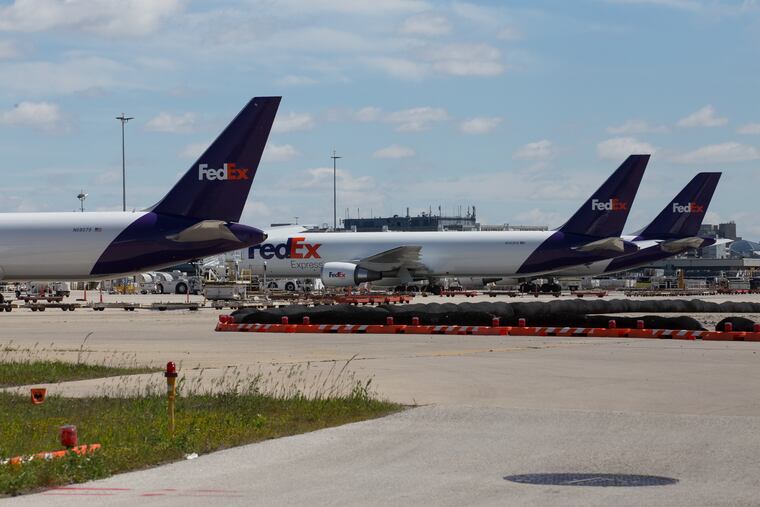Philly airport is included in first FAA awards of $3 billion in new infrastructure funds
Philadelphia International Airport will get $30.7 million from the law while $763,000 will go to Northeast Philadelphia Airport.

The Federal Aviation Administration announced Thursday how it will allocate the first $3 billion in new funds for airports from the infrastructure law, money that could spur upgrades in terminals and on the tarmac to help get passengers to planes more quickly and into the air on time.
It’s the first major new tranche of federal airport funding since the stimulus adopted after the financial crisis more than a decade ago. It also represents a new level of investment by the federal government in terminals — at an average of 40 years old — which could help airports update aging facilities by plugging gaps in existing funding sources.
“The Bipartisan Infrastructure Law has given us a once-in-a-generation opportunity to build safer and more sustainable airports that connect individuals to jobs and communities to the world,” Transportation Secretary Pete Buttigieg said. “With this new funding, urban, regional and rural airports across the country now can get to work on projects that have waited for years, modernizing their infrastructure and building a better America.”
Like much of the transportation funding in the $1.2 trillion legislation, the federal government won’t determine how the money is spent, leaving the decisions to individual airports. The money will start flowing at a time when airports are gradually recovering from the coronavirus pandemic, which nearly brought air travel to a standstill and left them dependent on billions in federal aid. While air travel has rebounded, airports expect to miss out on revenue, compared to prepandemic levels, for years to come.
The infrastructure money is divided through a formula set out in the law, broadly awarding funds based on an airport's size. Hartsfield-Jackson Atlanta International Airport, the nation's busiest, will receive $92.5 million this year, while hundreds of small airports will each get $110,000. In the Washington region, Dulles International Airport and Reagan National Airport will each get about $22 million, and Baltimore-Washington International Marshall Airport will get almost $26 million.
In all, the infrastructure legislation allocates $25 billion for aviation projects over five years. Of that, $15 billion will cover the grants announced Thursday, and airports will be able to compete for another $5 billion in grants. The remaining $5 billion is for the FAA to use to modernize its air traffic control system.
Philadelphia International Airport will get $30.7 million from the law while $763,000 will go to Northeast Philadelphia Airport (PNE).
At Philadelphia International, the new money will help support a planned expansion in cargo capacity that the airport announced in June. The $1.2 billion expansion plan will increase cargo’s footprint by 136 acres and nearly triple its building space from 600,000 square feet to 1.4 million.
The cargo program could generate an annual economic impact of $870 million for the region and create up to 6,000 permanent jobs and 5,000 construction jobs a year over the course of the project.
“The funding we are receiving for PHL and PNE will spur a-once-in-a-generation investment into these important regional assets,” said Division of Aviation CEO Chellie Cameron in a statement.
The management of BWI has a long list of projects it hopes the money will help cover, said airport spokesperson Jonathan Dean. That includes repaving the airfield, as well as upgrades to bathrooms, baggage handling systems, investment in an international arrivals area, and a connection after security between two concourses.
While the money might not transform the aviation system to the degree that tens of billions for Amtrak and transit agencies is set to change the nation's rail and bus systems, Airports Council International-North America says facilities are aging and have a significant backlog of projects. In an infrastructure survey published this year, the organization identified $115 billion in investments that airports say they need in the coming five years — including $40 billion in terminal projects.
"We will see a significant portion of this money go in some way to terminal projects," said Annie Russo, the council's senior vice president of government and political affairs. "It will be incredibly helpful in jump-starting projects."
The 2009 Recovery Act included $1.1 billion in funding for airport infrastructure, but Russo said opening the door to spending on terminals is new for the federal government — and something airport leaders pushed to be included in the bill. For years, airports have relied on the Passenger Facility Charge, a ticket fee, to fund building projects. It is set locally but was capped by federal officials at $4.50 per passenger two decades ago.
It is spending on terminals that passengers are most likely to notice. The money could be used to cover almost anything that doesn't generate revenue, Russo said, such as waiting areas at gates or common areas.
Greg Roybal, a spokesperson for Phoenix Sky Harbor International Airport, said officials are considering a bridge between two terminals, upgrades to garage lighting, and electrifying its vehicle fleet.
The funds also can be spent on projects such as runways and taxiways, which have long benefited from federal investment. While passengers might not think much about them, investments on the tarmac could smooth the experience of flying, airport officials say.
Roybal said Sky Harbor is eyeing a north-south taxiway that would allow planes to move around more easily, “reducing airfield congestion and delay.”